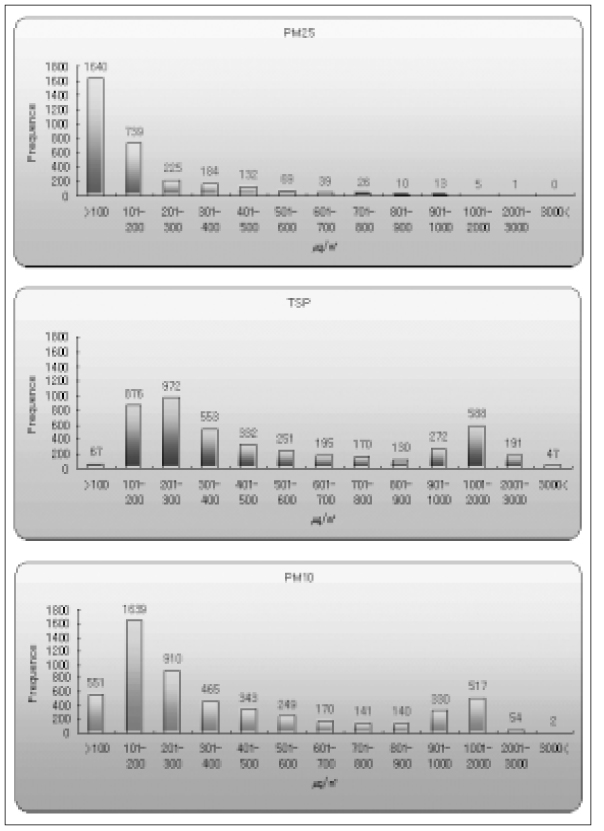J Korean Med Assoc.
2004 May;47(5):453-464. 10.5124/jkma.2004.47.5.453.
Physical and Chemical Characteristics of Asian Dust
- Affiliations
-
- 1Research Institute of Public Health and Environment, Seoul Metropolitan Government, Korea. mykim5@seoul.go.kr
- KMID: 2137881
- DOI: http://doi.org/10.5124/jkma.2004.47.5.453
Abstract
- The frequency record of sand storm occurrence in spring season has been renewed continuously along with its intensity and extended duration from the year 2000 to 2002 period. The airborne sand transported from long distance practically reduces visibility and influences atmospheric radiation energy balance. It can further affect the ecological system through the deposition on the earth's surface while offering the buffer effect to acid substance, because of its alkali content such as calcium. It is known that no chemical reaction proceeds between elemental components contained in transporting particles during sand storm period. The elements originating from soil sources and some cations increased with the occurrence of sand storm. However the elements of anthropogenic origin(Pb, Se and Zn) and anions(NH4- and N03-) decreased, possibly because of the dilution effect by the strong air flow from westward direction.
Keyword
MeSH Terms
Figure
Cited by 3 articles
-
Environmental diseases
Sang Baek Koh
J Korean Med Assoc. 2012;55(3):212-213. doi: 10.5124/jkma.2012.55.3.212.Toxicity and health effects of Asian dust: a literature review
Ho-Jang Kwon
J Korean Med Assoc. 2012;55(3):234-242. doi: 10.5124/jkma.2012.55.3.234.Toxicity and health effects of Asian dust: a literature review
Ho-Jang Kwon
J Korean Med Assoc. 2012;55(3):234-242. doi: 10.5124/jkma.2012.55.3.234.
Reference
-
1. Chung YS, MB Yoon. On the occurrence of yellow sand and atmospheric loadings. Atmospheric Environment. 1996. 30:2387–2397.
Article12. Huebert B, Bates T, Russell P, Shi G, Kim YJ, Kawamura K. An overview ACE-Asia; strategies for quantifying the relationships between Asian aerosols and their climatic impacts. J Geophys Res. 2002.3. Wang ZF, Akimoto H, Uno I. Neutralization of soil aerosol and its impact on the distribution of acid rain over East Asia: Observational evidence and Model simulation. J Geophy Res. 2002. 107:4389.5. Murayama T, Sugimoto N, Uno I, Kinoshita K, Aoki K, Liu NZ, et al. Ground-Based Network Observation of Asian Dust Events of April 1998 in East Asia 1. Transport Mechanism. J Geophy Res. 2001. 106:18345–18359.
Article7. Husar RB. Asian dust events of April 1998. J Geophy Res. 2001. 106:18317–18330.
Article8. Uno I, Emori S, Baldi M. Gryning Sven-Erik, Schiermeier Francis A, editors. Chemical transport model on-line coupled with RAMS for regional chemical climate. Air pollution modeling and Its Application XIV. 2001. Kluwer Academic/Plenum Pub;75–85.
Article10. Tanaka S, Onoue T, Hashimoto Y, Otoshi T. The influence of the soil dust transported from Asian continent by kosa phenomenon on the atmospheric in Japan by using the results of NASN data for 10 years. J of Japan Soc Air Pollut. 1989. 24(2):119–129.13. Park CK, Eo SM, Ki WJ, Kim KH, Mo SY. The Influence of Yellow Sand Phenomena on the Concentration Variation of Polycyclic Aromatic Hydrocarbons in Ambient Air of Seoul. J Korean Soc Atmos Env. 2001. 17(2):179–192.14. Kim MY, Shin JY, Cho SC, Kim J, Lee GW, Kim KH. Environmental Mobilization Characteristics of Total Gaseous Mercury in the Western Coast of Korea During the Yellow Sand Period. J Korean Earth Sci Soc. 2001. 22(6):480–490.
- Full Text Links
- Actions
-
Cited
- CITED
-
- Close
- Share
- Similar articles
-
- Toxicity and health effects of Asian dust: a literature review
- The Health Effects of Asian Dust Event
- Perceptions of the Asian Dust: Analysis of the Newspaper Articles about the Asian Dust
- From Historical Dust ail to Early Warning of Asian Dust Events in Korea
- Relationship between Workplace Physical and Chemical Hazard Exposures and Mental Health Problems in Korea



